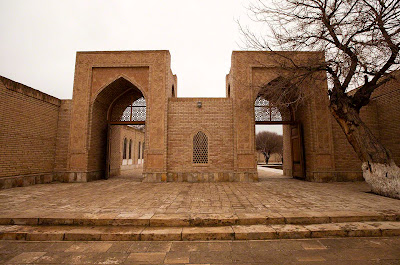Uzbekistan | Bukhara | Bolo Haus Mosque

Bolo-Hauz (Children’s Reservoir?) Mosque was reportedly built in 1712 by the Ashtarkhanid ruler Abul Fayud Khan (1711-47) for his mother, Bibi Khanum. Later it was apparently frequented by the emirs of Bukhara who lived in the nearby Ark. Bolo Haus Mosque (click on photos for enlargements) Bolo Haus Mosque This short minaret was added to the complex in 1917 by Shirin Muradov, a famous Bukhara craftsmen. Bolo Haus Mosque The entryway, or iwan , is a fairly recent construction, added to the mosque's eastern facade 1914-17 by the last Mangit ruler Sayyid Alim Khan (1910-20) Detail of entrance to Bolo Haus Mosque The porch in front of the Bolo Haus Mosque. The twenty columns are made from poplar, walnut, and elm wood. Porch of Bolo Haus Mosque Detail of wooden columns of Bolo Haus Mosqueue Detail of wooden columns of Bolo Haus Mosque Detail of wooden columns of Bolo Haus Mosque








